
Welcome to the Club of Amsterdam Journal.
Nature has a long history and it’s been known for some time that designers and architect find good solutions and ideas looking at nature. Nature is an inspiration when it comes to effective use of materials, construction of housing and other design challenges. But there is more to learn from nature.
Did you ever ask yourself questions like: How do swarms, flogs or herds work together? How do living organisms cooperate? How does nature grow or respond to changes? What about leadership?
Join us at the future of Social Biomimicry – Thursday, 23 February!
…. interested in knowing more and sharing thoughts and ideas …. email us!
Felix Bopp, editor-in-chief
Towards a Biomimicry Culture of Cooperation

By Elisabet Sahtouris, PhD
Adapted for the Club of Amsterdam Journal from a chapter in A New Renaissance:Transforming Science, Spirit & Society, Floris Books, London, 2010
Three major crises – in energy,economy and climate – are now confronting us simultaneously, globally, adding up to the greatest challenge in all human history. They are so great, so serious, that nothing short of a fundamental review, revisioning and revising of our entire way of life on planet Earth is required to face this mega-challenge successfully.
This situation, unprecedented in human history, actually makes this an amazing time of opportunity to create the world we all deeply want!
Is that an idle dream, an airy-fairy ‘create your own reality’ pitch?
Consider: We humans created the reality we have now. It was not imposed on us by fate or any other outside agency. While some may still claim we had nothing to do with global warming, few would deny we have ravaged our planet’s ecosystems and loaded our air with pollutants. How many would claim we had no choice in how to produce our energy, or insist that Mother Nature inflicted our money system on us? We humans dreamed up and then realized our economic systems, including our technological path via the exploitation of nature and our focus on consumerism and our extremes of human wealth and poverty. We are an extremely creative species. But something has gone very wrong; something we did not foresee, and we are having very serious trouble understanding and facing that.
If we really look at Nature, we see on the whole that She does not fix what isn’t broken. She is profoundly conservative when things are working well, and radically creative when they don’t. We would do well to forget our partisan politics and mimic this approach to life’s vagaries. Recall that in Arnold Toynbee’s classic study of civilizations that failed (1946), the two critical factors proved to be the extreme concentration of wealth and the failure to change when change was called for (Toynbee 1946). These are the current conditions of our global economy in a nutshell, and bigtime Change is now called for.
There were human cultural systems that we created such that they remained sustainable over thousands of years, so why is our most advanced, industrial, hi-tech super-economy, now reaching around the entire globe, proving to be unsustainable in only a few hundred years? To see how this could happen, we must first look at the whole issue of economics.
Economic basics
What is an economy? I will venture to define the essence of an economy as the relationships involved in the acquisition of raw materials, their transformation into useful products, their distribution and use or consumption, and the disposal and/or recycling of what is not consumed. This definition – and this is very important to understand – is as applicable to our human economy as to nature’s ecosystemic economies, as well as to the astonishingly complex economies operating within our own bodies.
Earth has four billion years of experience in economics and may well have something to teach us. Just for starters, nature recycles everything not consumed, which is why it has managed to create endless diversity and resilience, with ever greater complexity, using the same set of finite raw materials for all that time. Furthermore, with us or without us, she is likely to continue doing so for as long as the benevolent sun shines upon her, despite – or perhaps because – she suffers periodic crises that drive her creativity. Let’s look at how Earth faces these crises.
As we do, note that Earth’s economy is a truly global economy, composed of many and diverse interconnected local ecosystemic economies woven together by global systems of air, water, climate/weather, tectonics, migrations and, not least important, a single gene pool.
Crisis as opportunity in nature
We are facing an onrushing Hot Age. Around fifty-five million years ago, Earth had its last Hot Age. In between, since the advent of humanity, our species faced and survived at least a dozen Ice Ages. Only since the last Ice Age have we enjoyed the long – from a human perspective – benign, stable climate in which known human civilizations evolved. It was possible because the last Hot Age plus an Earth-rocking meteor, extinguished the massive reptiles and kicked off a creative wave of mammalian evolution. Crisis for some was opportunity for others in nature’s resourceful ways.
In the much older 520-million-year-old Cambrian era Burgess Shale, found between two peaks in the Canadian Rockies near Banff, Canada, lies fossil testimony to one of the greatest ‘opportunity’ responses to crisis in all Earth’s history. Interesting that it, too, happened during a time of warm seas and no polar ice – such as we ourselves may be facing – occurring relatively shortly after a ‘snowball Earth’ climate. In this Cambrian period before land plants and animals appeared, marine invertebrate life reached a fully modern range of basic anatomical variety that more than 500 million years of subsequent evolution has not enlarged. The fossil record of this ‘Cambrian Explosion’ shows a radiation of animals to fill in vacant niches, left empty as an extinction had cleared out the pre-existing fauna. Once again, crisis for some; opportunity for others.
Let’s continue deeper yet into the past. By the Cambrian era, Earthlife had already been through well over half its evolutionary trajectory in years. In fact, for the first half of Earth’s biological evolution – for roughly two billion years – archaea (archebacteria) had the whole world to themselves. They evolved amazing lifestyle diversity in their massive proliferation from the depths of the oceans to the highest mountain peaks and even the highest life ever reached in the air, dramatically changing whole landscapes and shallow seafloors as well as the chemical composition of the atmosphere. Their impact is yet to be truly understood outside the halls of science, although they pioneered economic situations and technologies such as harnessing solar energy, building electric motors and developing the first World Wide Web of information exchange we claim as human firsts, as I will describe. (Note our unconscious biomimicry!) My point here is that archebacteria, at the beginning of Earthlife’s evolution, were first to make extraordinary responses to global crises – crises of their own making, we should note, unlike the later great extinctions.
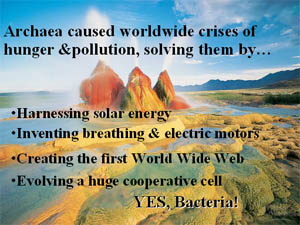
The first major such response was to a global food shortage that occurred because the first archebacteria, after spreading all over Earth, were eating up all the free food – the sugars and acids chemically produced via solar UV radiation. Their amazing response was to draw on their own gene pool to change their metabolic pathways such that they could harness solar energy to produce food in the process well known to us as photosynthesis. If we could copy it at a human scale, according to Daniel Nocera at M.I.T., it could fill all our energy needs as long as Earth and we ourselves live. (Note our need for biomimicry in this!)
Before photosynthesis, bacteria had to dwell in seawater or underground, away from burning sunlight. To function in sunlight, the new photosynthesizers were driven to invent enzymes functioning as sunscreens to protect themselves as they lived off the sun’s rays and the plentiful minerals and water available to them. Unfortunately, while they did extremely well, they inadvertently created the next big global crisis of atmospheric pollution, leading to the next notable example of taking crisis as opportunity.
Like today’s plants that inherited their lifestyle, the photosynthesizing archebacteria gave off oxygen as their waste gas. There were, as yet, no oxygen-needy creatures, so the highly corrosive oxygen, after as much of it as possible was absorbed by seas and rocks and soil reddened by its rusting effects, piled up in the atmosphere in highly significant and dangerous quantities. Along with its direct dangers of killing corrosion, this pollution created the ozone layer which caused further diminution of the old sugar and acid food supply requiring the free passage of UV through the atmosphere.
Once again, life responded with a stunning new lifestyle invention – a whole new way of living using oxygen itself to smash food molecules in the most hi-tech biological lifestyle thus far invented – the one we ourselves inherited from them and call ‘breathing’. Bacteria that breathed in oxygen gave off the carbon dioxide needed by the photosynthesizers, thereby completing a give and take exchange in which their plant and animal heirs, including us, still engage.
Life has a dynamic way of oscillating between problems and solutions, which seems to keep evolution happening. The ‘breathers’ needed food molecules to smash while food was becoming scarcer. Solution: they invented electric motors built into their cell membranes, vastly more efficient than human-designed motors up to the present, attaching flagella to them as propellers. These hi-tech breathers drilled their way into big sluggish fermenting bacteria, which I have called ‘bubblers’. (Sahtouris 2000). This initiated the era of bacterial colonialism in which the breathers invaded the bubblers for their ‘raw material’ molecules. Reproducing by division within the bubblers, they literally occupied them as they exploited and drained away their resources, leaving them weakened or dead. (Is human colonialism biomimicry?)
In this primeval Earth world, we can imagine the many conflicts over scarce food and overcrowding that wreaked havoc, yet simultaneously drove innovation. Eventually, in their encounters with each other, archebacteria somehow discovered the advantages of cooperation over competition: that feeding your enemy is more energy efficient (read: less costly) than killing them off.
Read that last sentence again, because it is the most important discovery any maturing species can make and is very much on our human agenda right now!
All along, in evolving different lifestyles, the archaea had been able to freely trade DNA genes with each other across all the different types in a great World Wide Web of information exchange in which any bacterium had access to the DNA information of any other. Thus they refined a myriad particular cell shapes and lifestyles or roles, such as fixing nitrogen or moving by whiplash propulsion or living in mats of millions.
The crowning glory of all their achievements was the evolution of gigantic collectives with highly sophisticated divisions of labour that became the only other type of cell ever to grace the evolutionary scene: the nucleated cells of which we ourselves are composed. This may have begun, as microbiologist Lynn Margulis and others worked it out, when invading breathers felt their bubbler host weakening and took on some ‘bluegreens’ (photosynthesizers) to make food for the entire colony. The breathers’ motors provided transportation by working in unison on the bubbler’s cell membrane to drive the colony into sunlight where the bluegreens could work as needed (Margulis 1998).
In such cooperatives, apparently each specialized bacterium donated the DNA it did not need to fulfil its special function into a common gene library that became the new cell’s nucleus. To this day our cells and those of plants, animals and fungi, contain the descendants of these archebacteria in the form of mitochondria (breathers) and chloroplasts (bluegreens).
Nucleated cells went through another billion years repeating the cycle of youthful competition and creativity to mature cooperation in the form of multi-celled creatures. That was the last great leap in evolution – around one billion years ago, bringing us closer to that Cambrian era, when this evolutionary model really took off as described earlier. Ever since, multi-celled creature have been competing when youthful and cooperating when mature.
Maturation through crisis
In my view as an evolution biologist, then, the essential pattern in evolution for all species from time immemorial is this very maturation curve from competitive, expansive, youthful economies to cooperative, stable, mature economies. One can see this in what ecologists classify as Type I Pioneer ecosystems and Type III Climax ecosystems today, as well as in looking back over Earth’s four billion year history of species’ econoomies.
Some species never make it to maturity. Much of humanity did-but only at the tribal level to which countless human groups matured in cooperation internally and with neighboring tribes, sometimes developing complex economies with large towns and many artifacts, as found at Catal Huyuk in Turkey and many other locations in Africa, Asia, North and South America. Mature cooperation, with other humans as well as with large animals no doubt played a large role in surviving a dozen Ice Ages as humanity did.
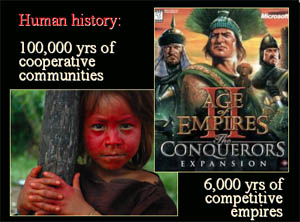
In the past 6,000 years or so, we built civilizations-relatively huge socio-economic political systems with complex infrastructures that were mostly internally cooperative despite occasional insurrections. But these mature cooperatives, like the nucleated cell and like the multi-celled creature before them, were new cooperative entities at yet another size scale, and therefore proceeded naturally in the youthful mode of expansionism in competition. Lo, the Age of Empires that shifted over time into national and then corporate empires, had begun!
And so human empires mimic rather well the expansive, competitive phase of juvenile species in nature from the original archaea (bacteria) to the grasses that evolved along with humans and are also still in that juvenile take-over, make-over whatever you can to stay in the game mode Darwin described so well. Interesting that humans and those youthful grasses – in the version humans call ‘grain’ or ‘corn’ – have come to depend on each other.
Yes, Darwinian evolution describes the juvenile phase, and that is precisely why the entrepreneurs of our Industrial Age loved that theory as much as the Soviet Union loved Kropotkin’s version of evolution, titled Mutual Aid, all about the cooperative phases of species evolution, which rationalized collectivism. In the first, community was sacrificed to the individual’s interest; in the latter the individual’s interest was acrificed to that of the collective. Two half theories that make a whole when put together and make the connections between the ecologists’ different types of ecosystems. The learning curve of maturation ties it all together in an elegant whole.
The recognition that our current way of life is unsustainable (literally implying we must live differently) is a new and vital insight, without which we could not see any need to change the way we live on what seemed like a limitlessly provident planet, now so obviously ravaged by our youthful empire building to a critical point, if not already beyond it.
All our technology has come through biomimicry-from spinning like silkworms and weaving like spiders, building like termites and tunneling like moles, flying like birds and computing like brains, to using radar like bats and sonar like dolphins, and so on and on. But now it is time for the biggest and evolutionarily greatest biomimicry feat of all: copying those of our ancestors who made it to mature sustainability, pulling back on our economic expansion just as our bodies did when reaching mature size and shifting to maintaining stable sustainability.
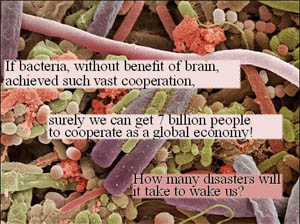
Looking at our recent history, we see many experiments in cooperation pushing us to our truly global cooperative maturity: from the United States of America to the European Union, from NATO and SEATO and other alliances to World Parliaments of Religion, a World Court and International Space Stations, from VISA cards crossing cultures and currencies to International Air Traffic Control, and so on and on.
The Internet is the largest self-organizing living system created by humanity and is changing everything. The top-down hierarchies that worked to maintain and expand empires are giving way to democratic and even more mature living systems ways of organizing and governing ourselves; even the gifting economies arising all over it, as well as in local communities, biomimic mature species economics.
If there is one biological system that can give us the clues in an up close and personal model available to us all, it is our own bodies. There is no more amazing or mature economy to mimic as we design our own future than the bodies in which each and every one of us, regardless of political persuasion, is walking around-bodies in which no organ either exploits the rest for its own benefit or interferes with diversity by trying to make the others more like itself.
Each of your up to one hundred trillion cells has some thirty thousand recycling centres in it just to keep all those proteins you are made of healthy. Each of those is as sophisticated as a chipper machine would be if you could stick a dead or damaged tree into one and get a healthy live tree out the other end instead of a pike of chips! And they exist along with a thousand mitochondrial banks in each cell, giving out free ATP stored-value debit cards 24/7 with no interest, not even pay-back of what you spent-a currency system we could well biomimic as soon as possible in place of our wealth-concentrating debt money.
It has become clear to me that the mature cooperative phase of species is often driven into existence by crises and I am happy to note how the vast majority of humans becomes highly cooperative in times of disaster, surviving predations of the very few to create wellbeing for the many. It is in our genes, our blood and bones, to cooperate. We have been through this before, just never before at a global size level.
Species that become sustainable – that survive a really long time – get to their mature collaborative phase while others, stuck in adolescent behaviours that no longer serve them, die out. Humanity now stands on the brink of maturity in the midst of disasters of our own making. Let us take heart from our most ancient Earth ancestors, the archea- the only other creatures of the living Earth to create global disasters through their own behaviour and solve them. Let us see if we can do as well as they did! Let a mature and cooperative global economy be our goal and let us make it as successful, as efficient and resilient, as our own highly evolved bodies.
The global economy we built as a resource-rapacious, competitive monopoly game based on debt money and powered by fossil fuels was a necessary youthful phase. We are ready now to leap into maturity. We the people can declare our solidarity with each other around the globe, stop making war on each other, roll up our sleeves, and do the positive work needed to develop clean energy sources, move coastal cities uphill, reinvent money, green deserts, and cooperate in all our cultural and religious diversity to build a world that works for all, whether or not our governments follow our lead.
As Rumi asked: Why do you stay in prison when the door is so wide open?
Elisabet Sahtouris PhD (www.sahtouris.com) is an internationally known evolution biologist, futurist, author and speaker living in Spain. With a post-doctoral degree at the American Museum of Natural History, she taught at MIT and the University of Massachusetts, contributed to the NOVA-Horizon TV series, is a fellow of the World Business Academy, and a member of the World Wisdom Council. Her venues include the World Bank, UN, Boeing, Siemens, Hewlett-Packard, South African Rand Bank, Caux Round Table, Tokyo International Forum, the governments of Australia, New Zealand and the Netherlands, Sao Paulo business schools and State of the World Forums. Author of EarthDance: Living Systems in Evolution; A Walk Through Time: From Stardust to Us; and Biology Revisioned with Willis Harman
Next Event

the future of Social Biomimicry
Thursday, February 23, 2012
Location: Volkskrantgebouw, Wibautstraat 150, 1091 GR Amsterdam
Supported by Agentschap NL
The conference language is English.
In the meeting of February 23, 2012 we would like to address some of the issues of social Biomimicry. We will present some common patterns from nature that are inspirational for social issues like: communication, teamwork, leadership, development of organisations and society. We will give an idea of how to translate these patterns to work situation, architecture of organisations, teamwork and future growth. Social Biomimicry gives a fresh new perspective and we also belief it will contribute to resilient and future-orientated organisations.
Meet our team:
Bowine Wijffels is working as consultant and process leader in environmental education and learning for sustainable development. Learning from nature of one of her passions.
Social Biomimicry – for project management, leadership, change in organisations
Douwe Jan Joustra, Program Manager and Consultancy, One Planet Architecture institute
Social Biomimicry and city planning – city as living system, spatial planning
and our moderator Caroline van Leenders. She works at Agentschap NL. Her focus point is how to create change in large scale governmental programs.
iCub – European humanoid robot
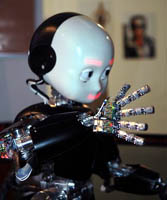
iCub.org is an open source cognitive humanoid robotic platform.
The European Commission has, in the last years, financed an innovative research project on cognition and sense of touch and their link to the development of intelligence. This project, taken in charge by the Italian Institute of Technology (IIT) in Genoa led to the creation of ICub, a humanoid robot, of the size of a three and a half years old child, to which the human skin could become a reality.
ICub is covered in triangular and flexible printed circuit, each containing twelve capacitive captors, which in turn have been covered with silicon pellicle and Lycra. Each triangle is also composed of twelve “tactile pixels” which enable the robot to experience and recognize the sensations which occur when a pressure is exercised on its envelop or “skin”. This humanoid baby has enabled great progress in the development of an artificial skin with similar characteristics to the human one that could be of great use for the future. Indeed, the important research investments and progress made in robot research will benefit greatly of such advancement for the abstract concept of skin for robots could become a reality. Potentially covered with an artificial skin based on the same principle and characteristics as the one developed and tested on ICub, humanoids could at last experience the sense of touch. The concept of a skin is still non-existent for robots but, becoming an “artificial reality” it would improve their abilities and possibilities of successful interaction with human beings.
Thus, in May 2012, the researchers of the ITT of Genoa will be sending to a selected number of laboratories in Europe the first components of a type of artificial skin, designed with ICub baby humanoid robot.
Robot learns like a toddler
Club of Amsterdam blog

Club of Amsterdam blog
http://clubofamsterdam.blogspot.com
October 23: Burning Issues: Education
October 23: Burning Issues: Resources: Water, Energy, Air, Food
October 23: Burning Issues: Health
October 25: Burning Issues: Climate Change / Sustainability (1)
October 25: Burning Issues: Climate Change / Sustainability (2)
October 25: Burning Issues: Economy / Stock Market / Poverty
October 25: Burning Issues: Waste / Pollution
October 23: Burning Issues: Globalization
October 20: The ultimate freedom: beyond time
October 5: Limits to Knowing
March 24: Socratic Innovation
News about the Future

Cheese to fuel batteries
Greek researchers, working on new sources for renewable energies, have come up with an interesting innovation in “fuelling” combustible batteries with wastes of the cheese industry. The cheese industry in a number of countries, such as Greece or France, rejects up to 70% of whey depending on the type of cheese produced. This industrial waste is toxic for the environment because of its organic content but could be used as a source of energy for combustible batteries for it is rich in lactose and sugar. Indeed, creating batteries with microbic crops within them could enable the production of electricity because of their consumption of whey, very rich in lactose and sugar which would stand here as sources of energy.
Traditional batteries produce electricity by using a catalytic material which oxides a combustible, such as hydrogen, and creates an electric current between two electrodes. Biobatteries function according to the same principle but the catalytic reaction is here created by bacteria which, by the absence of oxygen and chemical reactions consequent to the consumption of raw material such as whey, produce electricity.
These biobatteries could be applied in principle to many more industries, such as the pig breeding industry and the transformation of food industry, thus solving their waste issue in an innovative way. Nevertheless, it has been noted that refined combustibles would be more efficient than raw material such as sugar and lactose in the production of electricity with biobatteries. What’s more, these batteries for now can produce only a few milliwatts which is barely sufficient to charge a mobile phone. The lack of investment for research in this domain remains the biggest obstacle to the work of researchers wanting to improve the productivity of these batteries and eventually set them on the market.

Multitoe turns floors into massive multitouch screens you control with your feet
Mutitoe is a research project by the Human Computer Interaction Lab of Prof. Patrick Baudisch at Hasso Plattner Institute in Germany.
“Tabletop computers cannot become larger than arm’s length without giving up direct touch. This prevents tabletop applications from dealing with more than a few dozen on-screen objects. We propose direct touch surfaces that are orders of magnitude larger by integrating high-resolution multi-touch into back-projected floors, while maintaining the purpose and interaction concepts of tabletop, i.e., direct manipulation.
We based our design on frustrated total internal reflection because its ability to sense pressure allows the device to see users’ soles when applied to a floor. We demonstrate how this allows us to recognize foot postures and to identify users. These two functions form the basis of our system. They allow the floor to ignore inactive users, identify and track users based on their shoes, enable high-precision interaction, invoke menus, as well as track heads and allow users to control several multiple degrees of freedom by balancing their feet.”
Morphogenetic Design Approach
by Julia and Göran Pohl
Pohl Architekten
“Cocoon_FS is a brilliant and bizarre-looking lightweight modular building inspired by marine phytoplankton and pioneered by Pohl Architects in cooperation with PlanktonTech. A high strength to weight ratio, translucent shell, and low material usage make this eye-catching prefab fantastically easy to transport.” – Inhabitat
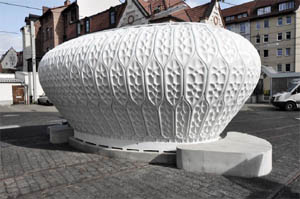

Recommended Book
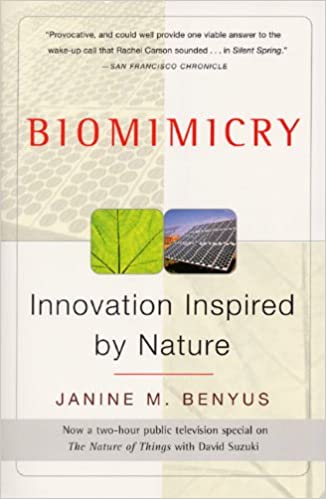
Biomimicry: Innovation Inspired by Nature
By Janine M. Benyus
If chaos theory transformed our view of the universe, biomimicry is transforming our life on Earth. Biomimicry is innovation inspired by nature – taking advantage of evolution’s 3.8 billion years of R&D since the first bacteria. Biomimics study nature’s best ideas: photosynthesis, brain power, and shells – and adapt them for human use. They are revolutionising how we invent, compute, heal ourselves, harness energy, repair the environment, and feed the world.
Science writer and lecturer Janine Benyus names and explains this phenomenon. She takes us into the lab and out in the field with cutting-edge researchers as they stir vats of proteins to unleash their computing power; analyse how electrons zipping around a leaf cell convert sunlight into fuel in trillionths of a second; discover miracle drugs by watching what chimps eat when they’re sick; study the hardy prairie as a model for low-maintenance agriculture; and more.
Rich with Youtube

by Raphaelle Beguinel, Assistant Editor, Club of Amsterdam Journal
Youtube no longer appears to be just an interactive platform where users share videos, inform and entertain themselves. Founded in 2005 by three former PayPal engineers, the company has grown into one of the biggest websites and platforms on the Internet with the opportunity for users to earn money by sharing popular videos. Indeed, a number of users, especially families, have been earning a lot of money just by sharing videos of their children or funny daily-life episodes on-line. When the video appears to be popular enough, that is viewed by a significant number of Youtube users, the company contacts the family or individual having posted the video to establish a lucrative partnership. With such a partnership the advertising revenue from the ads showed before viewing the video will be split between Youtube and the user having posted the popular video on the website. What’s more, a set amount of money will be given to the “poster” by the company every time the video will hit, for example, an additional thousand views. As an example, a teenager named Jamie posted a video featuring his brother crying over having to stop playing a computer game. The video being viewed by more and more Youtube users, Jamie was contacted by the company and a partnership was established. The contract established that for this video Jamie would now receive 69 euros for each additional thousand views. Youtube even enabled Jamie to create his own Youtube channel to post videos about his brother and be able to post more videos on a regular basis.
A growing number of individuals and families have thus been able to earn a lot of money just by posting videos with an important “popularity potential” and turn Youtube into a more or less regular source of revenue. Mr. Davies-Carr, having made a first Youtube buzz with a popular video named “Charlie bit me!” featuring his two sons, also created his own Youtube channel and posts videos of his daily family life every six weeks with each of them obtaining several millions of hits. Mr Davies-Carr, with this Youtube money, was able to pay for his children’s school fees and invest in better material for his videos.
Many other video success stories can be taken as examples to illustrate these Youtube partnerships between the company and the posters. For example, the video “baby shakira” topped all previsions attaining more than 24 million views; and quite a few other videos, close to the “Charlie bit me” concept, have totalized several million views such as “Aydan’s funny laugh” (5 million views).
The company recently announced having developed an algorithm enabling the company to detect up-and-coming videos by determining their “popularity potential”. This algorithm will enable Youtube to contact and establish advantageous contracts with the authors of these promising videos as fast as possible and prevent any competition from other video channels such as Daily Motion or Video BB. On the user’s side, there are several conditions for his video to become popular enough and interest Youtube enough for the channel to propose a partnership. First, the essential condition is that the video needs to be viewed by at least several millions of users and needs to be viewed more and more to attract the channel’s attention. Once Youtube has contacted the author of the popular video two conditions need to be continuously fulfilled: that the video keeps becoming more and more popular with a significant amount of additional views every day, month or week; and that the author keeps on posting more videos with the same popularity potential.
This Youtube innovation reveals an important trend where Internet users become increasingly active on the web. They are no longer interested only in sharing, entertainment or information consulting but also in the opportunities of investing and taking advantage financially of such a system. Nevertheless it is important to note that even if such partnerships are growing in proportion they still remain an infinite minority of users which ensures a lucrative deal for Youtube. Indeed, it will become more and more difficult for a user to attract the channel’s attention for the competition is becoming fiercer with more and more users adding more and more videos by the day.
aydan’s funny laugh – he’s a happy baby! best baby laugh!
Michael Gazzaniga – The Interpreter
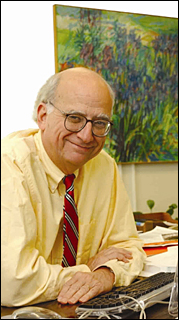
Michael Gazzaniga is a Professor of Psychology and the Director for the SAGE Center for the Study of Mind at the University of California Santa Barbara. He oversees an extensive and broad research program investigating how the brain enables the mind. Over the course of several decades, a major focus of his research has been an extensive study of patients that have undergone split-brain surgery that have revealed lateralization of functions across the cerebral hemispheres.
The Interpreter
The third in a series of Gifford Lectures by Professor Michael Gazzaniga. Recorded 15 October, 2009 at the Playfair Library Hall, the University of Edinburgh.The interpreter is the device we humans enjoy that provides us with the capacity to see the meanings behind patterns of our emotions, behavior and thoughts.
This concept is central to understanding the relationship between our brain and our strong sense of self.
In a way, it is the device that liberates us from our automatic ways spelled out in Lecture 1 and 2.
The interpreter constructs the sense that there is a me arising out of the ongoing neuronal chatter in the brain and making all of lifes moment-to-moment decisions.
Our compelling sense of being a unified self armed with volition, deployable attention and self-control is the handiwork of the interpreter, for it brings coherence to a brain that is actually a vastly parallel and distributed system.
This view stands in contrast to much neuroscientific theorizing or existential musing about our unified, coherent nature.
In most models of brain and cognitive mechanism, one can identify, as Marvin Minsky once said, the box that makes all the decisions.
Futurist Portrait: Sheryl Connelly

Sheryl Connelly, manager of Ford Global Trends and Futuring
“Scenario planning isn’t about predicting the future. You really need to be careful about that.”
Sheryl Connelly currently stands as a major reference in the field of scenario planning and futurism thanks to her unique approach to innovation and her established expertise in business, marketing and trend forecasting. Former graduate from the Michigan State University, where she obtained a bachelor in finance, Connelly then graduated from the University of Detroit-Mercy in law and business administration at a master’s degree level. She exercised shortly as an attorney before entering Ford Company at the Marketing and Sales’ company division. She entered the Global trend and Futuring division of the company seven years ago as manager.
Throughout the years, Sheryl Connelly has managed to use her knowledge and experience in an unconventional way, representative of her professional career, becoming an expert in studying, analyzing and predicting future trends that might impact the Ford products. Using her high abilities in communication, business and marketing expertise, academic and empirical knowledge, and trans-field vision, Connelly, as an example, studied and anticipated the now established consumer tendency of rising carefulness in purchase and the growth of incremental purchases. The analysis of consumer behavior and global trends is at the heart of Sheryl Connelly’s work at Ford’s Global Trend and Futuring division for it has proven highly valuable for research and development, innovation and marketing activities in a world ever more uncertain and unpredictable.
In addition to her work as manager at Ford’s Global Trend and Futuring, Connelly is a sought-after speaker, having participated to numerous talk-shows, professional gatherings and association meetings such as the TedX Talks (2011), the American Marketing Association’s Marketing Research Conference (2009), the OMMA (Online Media, Marketing and Advertising) Global conference in 2011. Trend forecaster, futurist and speaker, Sheryl Connelly is also a licensed attorney and an artist.
Innovate: Uncertainty
Agenda

Season Events 2011/2012
NEXT Event:
February 23, 2012 the future of Social Biomimicry
What we can learn from nature
Location: Volkskrantgebouw, Wibautstraat 150, 1091 GR Amsterdam
Supported by Agentschap NL

March 29, 2012
the future of Languages
Location: OBA – Openbare Bibliotheek Amsterdam, Oosterdokseiland 143, 1011 DL Amsterdam
In collaboration with the British Council
April 26, 2012
the future of Germany
Location: Amsterdam
May 31, 2012
the future of Taxes
Location: Info.nl, Sint Antoniesbreestraat 16. 1011 HB, Amsterdam
Supported by Info.nl
June 28, 2012
the future of Urban Energy
Option: Guided Tour 17:00
Location: Van Eesterenmuseum, Burgemeester De Vlugtlaan 125, 1063 BJ Amsterdam
Supported by the Van Eesterenmuseum
Credentials
Felix Bopp, Editor-in-Chief
Raphaelle Beguinel, Assistant Editor







Customer Reviews
Thanks for submitting your comment!